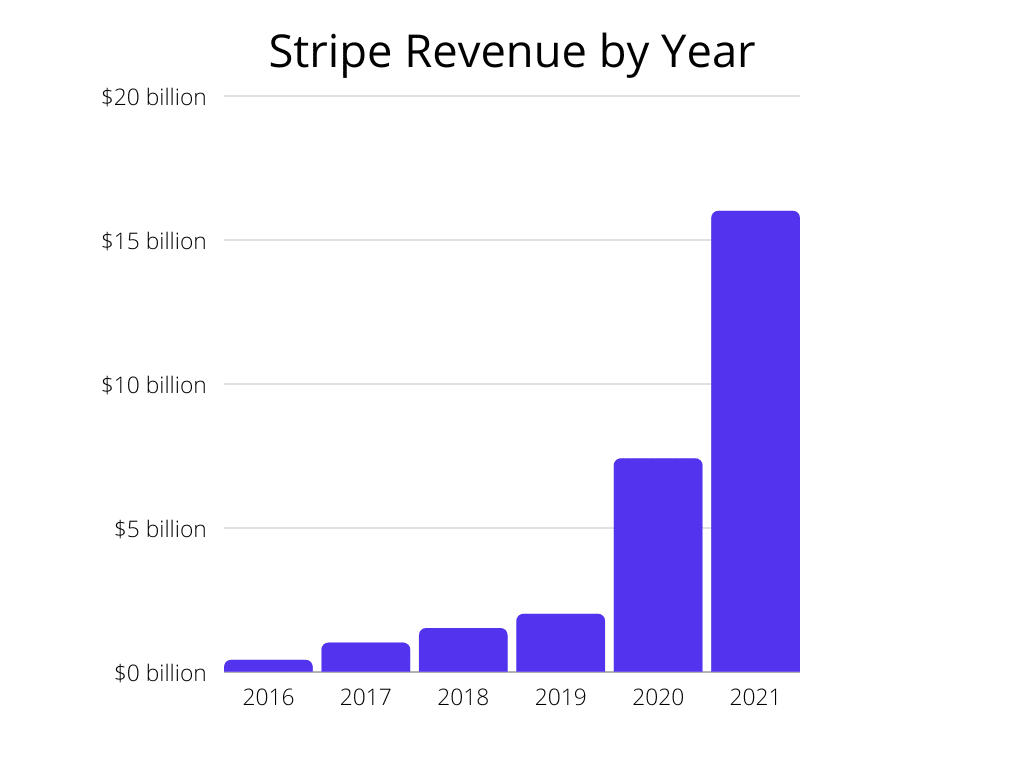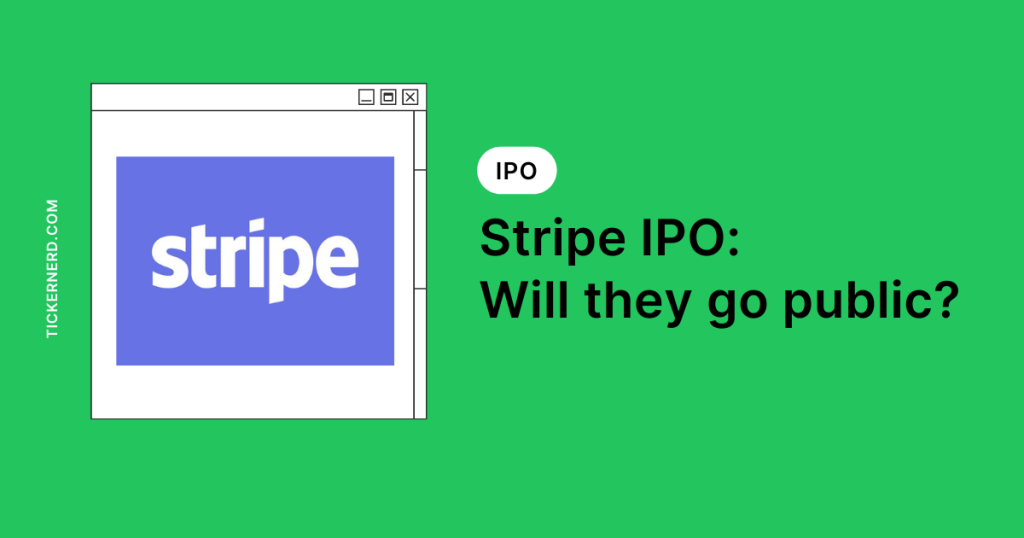Overview
- Stripe's IPO is speculated to happen in 2024 (potentially 2025).
- The company is reportedly opting for a direct listing versus a traditional IPO.
- There is currently no news surrounding its IPO date.
- Private tech companies have avoided listing on public stock markets since late 2021 due to poor market conditions.
| Stripe IPO Date (Predicted): | 2024-2025 |
| Stripe Valuation: | $50 billion |
| Total Revenue (2021): | $15.7 billion (estimated) |
| Total Funds Raised: | $8.7 billion |
| Number of Employees: | 7,500+ |
| Headquarters: | San Francisco, California |
| Founded: | 2010 |
Stripe's journey to an IPO
Stripe has grown from a $20 million valuation back in 2011 all the way to a $50 billion valuation in 2023 (a return of 2500x). This makes it one of the most valuable privately held companies in the world. The company has raised around $8.7 billion in funding over the course of 21 funding rounds from the likes of Founders Fund, Thrive Capital and Goldman Sachs.
When speaking about a potential Stripe IPO, co-founder John Collison seemed happy to keep the company private. This was in 2021 when the company was valued at $95 billion. However, it now looks like the company might have to hit the public stock market.
The reason? Veteran employees' (and former employees') 10-year stock options are expected to expire at the end of 2023. This a problem that many private companies face that are at a similar size as Stripe. A potential solution to this problem is taking the company public which will provide liquidity for employees to sell their Stripe stock. There is speculation that Stripe might go public as soon as this year. According to CNBC, if Stripe does go public it will most likely be a direct listing rather than a traditional IPO.
The other option is opting for a secondary offering. A secondary offering would allow current Stripe shareholders to cash out and sell their shares to new shareholders. Since these transactions would take place on the secondary market for private stocks the people who would buy shares are typically VC firms or angel investors.
According to various sources, Stripe's market share in the payment processing industry is estimated to be between 8% and 25%. One way of interpreting this stat is for every dollar that gets spent online, between 8c and 25c gets processed by Stripe. As per Statista, worldwide digital transactions amounted to approximately $8.35 trillion in 2022. When we put this into perspective it's clear why investors want to buy up Stripe shares.
How does Stripe make money?
Stripe's technology might be complex but it's business model is simple.
Stripe collects a percentage of every transaction that gets processed through its platform. These fees can range between 1.75% to 2.9% plus a $0.30 charge per transaction. The fees Stripe charges depend on the country you're operating in, whether you're processing domestic or international cards as well as the volume of payments you need to be processed.
Many businesses need a secure platform to collect payments. Building a bespoke solution is out of the question for most businesses as it involves serious technical and regulatory hoops to jump through.
Stripe also generates revenue from additional services including (but not limited to) Stripe Billing for subscription services, Stripe Connect for marketplaces and Stripe Atlas for starting a business. Stripe's product offering is surprisingly extensive. Each service comes with its own pricing model with some charging a flat amount per transaction, a percentage per transaction, a flat monthly fee or a one-time payment.
Stripe has generated serious cash flow from using this scalable business model. As its clients grow so does Stripe's revenue. The numbers below show how quickly the company has been able to grow its revenue.
- 2016: $450 million
- 2017: $1 billion in revenue
- 2018: $1.5 billion in revenue
- 2019: $2 billion in revenue
- 2020: $7.4 billion in revenue
- 2021: $15.7 billion in revenue

Please note that these figures were collected from third-party sources which may be inaccurate. Since Stripe is still a private company it has not publicly revealed its financial statements or performance.
How to buy shares in Stripe pre-IPO
If you're reading this article there's a good chance you're looking to buy Stripe stock before its upcoming IPO. While it's typically tricky for retail investors to buy pre-IPO shares of a private company, there are a few potential ways you can make it happen:
- Secondary Marketplaces: Platforms like Forge Global, SharesPost or EquityZen can be used to buy pre-IPO shares of private companies, often from current and former employees or early investors looking to sell. The downside is these platforms usually require you to be an accredited investor. Plus, there's a long queue of investors looking to buy Stripe stock so even if you manage to find shares available you'll likely have to pay a premium.
Pros: Potential access to shares before IPO.
Cons: High prices, limited availability, and need for accredited investor status. - Crowdfunding Platforms: Some crowdfunding platforms allow retail investors to invest in startups. However, these platforms usually list early-stage startups, and a company like Stripe would likely be considered too late-stage to be listed on one of these platforms.
Pros: Accessible to non-accredited investors.
Cons: Stripe may not be available. - Mutual Funds: Certain mutual funds or ETFs invest in private companies. By investing in these funds, you indirectly own a piece of the companies they hold, potentially including Stripe. For example, The Pengana Private Equity Trust (ASX: PE1) is a publicly traded investment company with a portfolio of global companies that includes private unicorns (+$1 billion market cap) such as Stripe, ByteDance, SpaceX, Instacart and Wise.
Pros: Accessible to all investors, diversification of risk.
Cons: Lack of control over investments, potential for high fees, indirect ownership. - Direct Investment: If you're an accredited investor, you could try to negotiate a direct investment with Stripe. This is a long shot, as it usually requires substantial capital and the right connections.
Pros: Direct ownership of shares.
Cons: Requires accredited investor status, significant capital, and connections. - Invest in publicly-traded Stripe competitors: If you're looking for exposure to fintech companies like Stripe you could invest in its competitors including Paypal and Block. Apple, Google and Amazon also are eating into the payment processing market. The downside is investing in these companies isn't the same as investing in Stripe. Pros: Exposure to the digital payment processing market.
Cons: No exposure to Stripe.
Remember, investing in private companies (even Stripe) is risky. None of the options above is a recommendation. Always consider seeking investment advice from a financial advisor before making these types of decisions.
Notable investors in Stripe
There are currently 57 institutional investors who hold Stripe stock. These include:
- IDA Ireland
- SquareOne Capital
- Thrive Capital
- Founders Fund
- GIC
- MSD Partners
- Temasek Holdings
- Goldman Sachs Asset Management
- General Catalyst
Source: Crunchbase
Who founded Stripe?
Stripe was founded in 2010 by Irish brothers, John and Patrick Collison, in Palo Alto, California. Prior to Stripe, they co-founded a software company, Shuppa, in Limerick, Ireland in 2007, which later merged with Auctomatic and was subsequently sold for $5 million when they were teenagers. This was only the beginning of their entrepreneurial journey.
John Collison, born in 1990, was the youngest self-made billionaire in 2016. He holds 8 A1 and 2 A2 grades in the Irish Leaving Certificate examination and studied at Harvard University. In 2022, his personal net worth was estimated at US$11.4 billion, ranking him the 187th richest person in the world.
Patrick Collison, born in 1988, won the 41st Young Scientist and Technology Exhibition in 2005 at the age of sixteen, for a project on artificial intelligence. He began learning computer programming at the age of ten and attended the Massachusetts Institute of Technology before dropping out to start businesses.
In 2016, an investment in Stripe valued the company at $9.2 billion, making the Collison brothers the world's youngest self-made billionaires, worth at least $1.1 billion each. Both of their net worths are likely to be much higher in 2023 after Stripe's recent valuation of $50 billion.
Who are Stripe's competitors?
Stripe operates in the highly competitive payment processing space that has exploded with the rise of e-commerce which kicked into overdrive after the COVID-19 pandemic.
Stripe's competitors include PayPal, Square, Adyen, Chargebee plus several other players. Since Stripe doesn't only offer one service, it has different competitors for each of its business lines.

Note: This graphic was created by The Generalist, who put together a fantastic briefing on the future of Stripe.
PayPal, one of the earliest entrants in the digital payments space, is arguably Stripe's biggest competitor due to the size of its customer base and portfolio of competing products. Fun fact: Two key figures of PayPal (Peter Thiel and Elon Musk) both invested in Stripe back in 2011.
Meanwhile, Square has carved out a niche among small and medium-sized businesses, thanks to its mobile point-of-sale system and comprehensive suite of business tools. As for Adyen, the Dutch company caters to companies operating globally that need a single platform to handle transactions in multiple currencies and payment methods.
Stripe competitor's market cap
PayPal Holdings Inc: $76.5 billion
Adyen NV: $47.4 billion
Block Inc: $38.78 billion
Stripe, Inc: $50 billion
Figures as of 23 June 2023
The payments space is constantly changing, Stripe needs to be on the front foot if it wants to deal with emerging disruptive technologies including cryptocurrency and blockchain products. Tech giants have also quietly been moving into the fintech space over recent years. Apple launched its own high-yield savings account by partnering with Goldman Sachs while Google is planning serious moves with its payments strategy after hiring several former execs from PayPal.
Finally, Stripe also faces regulatory risks. As online transactions grow, so does the attention from regulators. Changes in data protection laws, anti-money laundering, fraud prevention or digital tax rules could impact Stripe's business and increase its cost of compliance.
When Is the Stripe IPO Date?
At the time of writing, there isn't a confirmed date for Stripe's IPO.
Although, according to an internal memo in early 2023 the co-founders John and Patrick Collison promised employees that they will either take the company public or allow employees to sell shares on the secondary market. It looks like Stripe is leaning towards the IPO option after it was revealed they hired Goldman Sachs and JPMorgan. The investment bankers were reportedly hired to help Stripe explore the listing process.
The IPO market for tech companies has been cold since 2021. This trend looks set to continue into 2023 with high interest rates, a weak economy and negative investor sentiment forcing companies to delay their IPO plans.
Frequently Asked Questions
Since Stripe isn't a public company it's difficult to determine if the company is profitable. Most high-growth tech companies sacrifice profitability in the short to focus on acquiring more users or customers.
An IPO date has not been confirmed, but speculation suggests the Stripe IPO could happen as soon as next year in 2024.
Stripe was valued at $50 billion in March 2023 after raising $6.5 billion for its Series I. This is a 47% decline from its previous valuation of $95 billion in 2021. The company noted that it “does not need to raise capital to run its business”.





